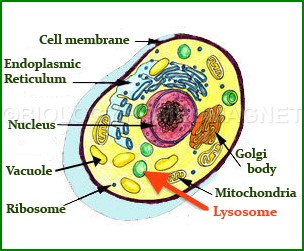What is Lysosomes?
Lysosomes are membrane bound vesicular cytoplasmic organelles containing hydrolytic enzynes. So, Lysosomes are specialized vesicles within cells that digest large molecules through the use of hydrolytic enzymes. They are found in almost all animal cells and remain scattered in the cytoplasm. Lysosomes are not seen in plant cells except those of meristematic tissue. The number of Lysosomes in animal cells is variable. These are present in large numbers in secretory cells and white blood cells.
Origin of Lysosomes
By the joint action of Endoplasmic Reticulum and Golgi body the Lysosomes are formed. The hydrolytic enzymes of Lysosomes are synthesized in the rough Endoplasmic Reticulum and then passed to the Golgi body, from where in conclusion by a process of budding, membrane bound and enzyme filled vesicles are released in the cytoplasm which is called Lysosomes.
Structure of Lysosomes
Just like membrane enclosed vesicles Lysosomes generally look like. The surrounding membrane is a single membrane like the cell membrane. The average diameter varies from 0.2-0.8 urn. The shape, size and internal structure of Lysosomes are variable in nature. In some cases, the inner part is denser than its outer part, while in others the outer part is denser than the inner part. There are granules and minute vacuoles are seen within Lysosomes. The Lysosomes contain hydrolytic enzymes, where as the micro-bodies contain oxidative enzymes. So that, though Lysosomes and micro-bodies have similar structures because both are single membrane bound, small, vesicular organelles containing specific enzymes but they should not be confused.
Functions of Lysosomes
In brief the Lysosomes has the following types of functions:
i) Extracellular digestion
ii) Intracellular digestion
iii) Bactericidal action
iv) Fertilization
v) Hormone secretion
vi) Protection from diseases.
Extracellular digestion
Newly formed Lysosomes are called primary Lysosomes that contain a specific type of enzyme. Some cells exude Lysosomes enzymes into their surroundings for hydrolysis or digestion of extracellular materials. This is called extracellular digestion. Saprophytic fungi derive their nutrition by this type of extracellular digestion.
Intracellular digestion
Digestion of a material within a cell is called intracellular digestion. Depending upon whether the material to be digested is exogenous or endogenous it may be either of the two types respectively : -
a ) heterophagy
b) autophagy
Heterophagy
This is a process in which a material engulfed by a cell is digested within it. The material engulfed by phagocytosis or pinocytosis forms a digestive vacuole or phagosome which then fuses with a primary Lysosomes to form a secondary Lysosomes or heterophagosome. Inside it, the food particles are hydrolysed and the, digestion products are absorbed into the cytoplasm across its membrane. If some undigested residue is left in the heterophagosome, such Lysosomes are called residual body which expels the excretory materials from the cell.
Autophagy
Autophagy is a process by which the old, non-functional and spoiled organelles of a cell are digested by its own lysosomal enzymes. In this process, a primary Lysosomes engulfs a non-functional organelle to form an autophagosome within which the organelle is digested and its constituents are absorbed into the cytoplasm. The hydrolytic enzymes of Lysosomes remain enclosed within its membrane so that the living and active mechanism of a cell are protected from autolysis. It to be noted that the hydrolytic enzymes are released in the cytoplasm and the entire cell is self digested which is called autolysis of a cell.
Bactericidal action
Lysosomes of phagocytic cells contain bactericidal agents that help to kill and destroy the bacteria engulfed by the cell.
Fertilization
Throughout fertilization, the lysosomal enzyme secreted from the sperms disperses the cells covering the ovum so as to make possible union of gametes. This is a extracellular digestion by lysosomal enzymes.
Hormone secretion
Discharge of thyroid hormone-from its site of storage in the gland is mediated by the action of lysosomal enzymes of thyroid cells.
Protection from diseases
Not working of Lysosomes is associated with a number of diseases like inflammation, arthritis, storage disease, cancer etc.
Biology related pages:
- Biology
- Branches of Biology
- Biological classification
- Origin of Life
- Biochemical Origin of Life
- Smallest unit of Life
- Types of Cells
- Eukaryotic Cells
- Cell Cytoplasm
- Golgi body
- Mitochondria
- Function of Endoplasmic Reticulum
- Ribosome Structure
- Lysosomes
- Microtubules
- Cell Wall
- Cell Nucleus
- Cell Nucleus Structure
- Chromosomes
- Chromosome Structure
- DNA Replication
- X and Y Chromosomes
- Cell Membrane
- Cell Junctions
- Cell Division
- Amitosis
- Mitosis
- Meiosis
- Meiosis Stages
- Respiration
- Cellular Respiration
- Process of Respiration
- Digestion
- Genetics
- Gene
- Mendel’s Experiments
- Natural Selection
- The Law of Segregation
- Genetic Variation
- Crossing Over
- Gene Mapping
- Transgenic Plants
- Mutation
- Gene Mutation
- Chromosomal Mutations
- Ecological Community
- Ecosystem
- Structure of ecosystem
- Sweat Glands
- Causes of overpopulation
- Effects of overpopulation
- Population Control
- Air Pollution


